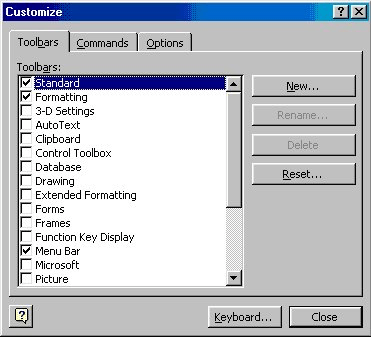Recently, subscriber Debbie Galle wrote and asked how to add the Synonyms option to the shortcut menu that pops up when you right-click on text. She noted that some of her users had the option in Word 2000 and some did not. Before getting to the answer, a short side trip is in order...
For users of Word 2000 and later versions, the synonym list that is available when right-clicking on regular text is a very handy feature. Whoever thought up the idea of providing a right-click shortcut access to a synonym list was a bright person. But that person used a clever trick to implement the idea. Also, Microsoft didn't go far enough with the implementation because the right-click synonyms list feature only got added to the "Text" set of shortcut menus. This means the synonym list is only available on a right-click shortcut menu when the user right-clicks on standard text. It doesn't show up on right-click shortcut menus for any other text item (e.g. text in a table, text in a list, text in a footnote, etc). What makes it worse is that Microsoft didn't provide an easy-to-use "synonyms list" command that could be dragged out of the Customize dialog box to customize other menus.
The problem here is that the "trick" used in the synonyms shortcut list feature works by using some special built-in programming. The synonym list is actually built on-the-fly and the fly-out menu is then customized on-the-fly by the built-in code. Each synonym listed on the fly-out "Synonyms >" menu is actually a temporarily added shortcut sub-menu item. Because this synonym list is created dynamically through built-in programming, there isn't a single Word command that exists to drag onto the shortcut menu.
The Knowledge Base touches on this subject in article Q229749. However, the article hides Microsoft's potential embarrassment over this short-sighted omission by being overly brief and skirting around the issue. The article points out that right-click shortcut menus are context sensitive but what it doesn't say is why there isn't a Synonyms > command in the Customize dialog box nor how to add this feature to shortcut menus where one wants this feature to appear. The suggested workaround is not particularly helpful, either. It simply suggests adding the "Thesaurus..." command to any shortcut menus where one wants to provide access to synonyms. All this does is open the normal Thesaurus dialog box--definitely not the same thing as a fast-access shortcut list of synonyms. Yet, there is a way the "Synonyms >" feature can be added to other shortcut menus, which we'll get to in a moment.
Meantime, Debbie mentions that some users have the shortcut access to the right-click "Synonyms >" list feature and others don't. If they truly don't have the feature on regular text, then perhaps someone has customized some of the systems to remove the synonyms list. The feature is included on the standard text shortcut menu by default even in an upgrade, but it may have something to do with the Normal.dot those particular users had in use when they upgraded from an earlier version of Word/Office. Whatever the cause, the only way to fix this is to completely reset the shortcut menus--which means re-customizing any other shortcut menu customizations after doing the reset. Note however, that resetting the shortcut menus doesn't affect existing customization of other toolbars or menus.
You can reset the shortcut menus by following these steps:

Figure 1. The Toolbars tab of the Customize dialog box.
Having reset the shortcut menus, the "Synonyms >" list fly-out will now appear when right-clicking any word within any standard text. The way to add the "Synonyms >" shortcut list feature to other shortcut menus is through these steps:
WordTips is your source for cost-effective Microsoft Word training. (Microsoft Word is the most popular word processing software in the world.) This tip (649) applies to Microsoft Word 2000, 2002, and 2003.

Learning Made Easy! Quickly teach yourself how to format, publish, and share your content using Word 2021 or Microsoft 365. With Step by Step, you set the pace, building and practicing the skills you need, just when you need them! Check out Microsoft Word Step by Step today!
One part of the grammar tools provided with Word is a thesaurus that helps you find all sorts of word variations. One ...
Discover MoreEver want Word to display a thesaurus for your country's version of English? This tip explains how to find the different ...
Discover MoreAntonyms are words that have opposite meanings. The grammar tools available in Word can suggest antonyms for some words. ...
Discover MoreFREE SERVICE: Get tips like this every week in WordTips, a free productivity newsletter. Enter your address and click "Subscribe."
There are currently no comments for this tip. (Be the first to leave your comment—just use the simple form above!)
Got a version of Word that uses the menu interface (Word 97, Word 2000, Word 2002, or Word 2003)? This site is for you! If you use a later version of Word, visit our WordTips site focusing on the ribbon interface.
Visit the WordTips channel on YouTube
FREE SERVICE: Get tips like this every week in WordTips, a free productivity newsletter. Enter your address and click "Subscribe."
Copyright © 2025 Sharon Parq Associates, Inc.
Comments